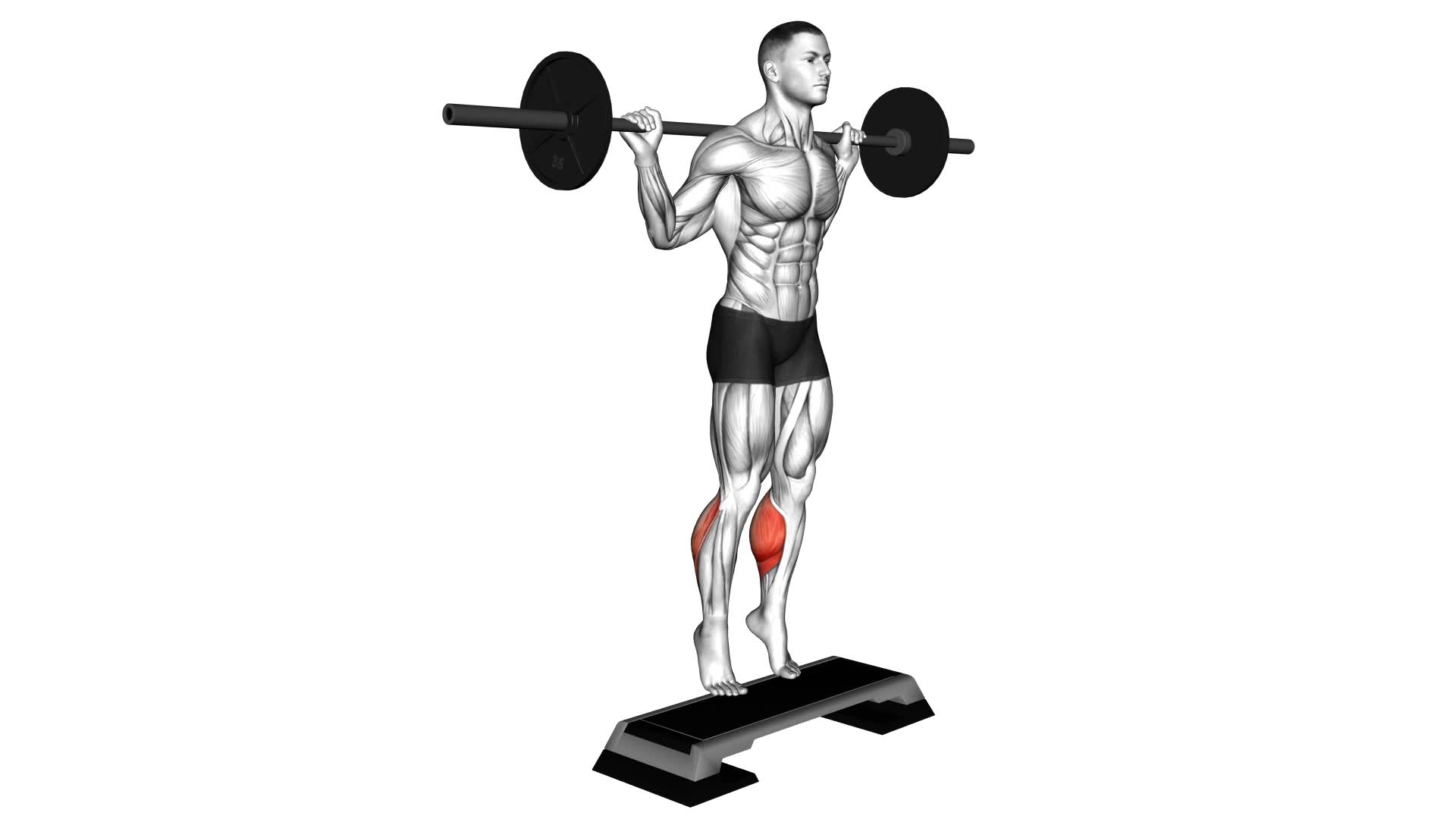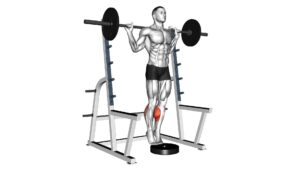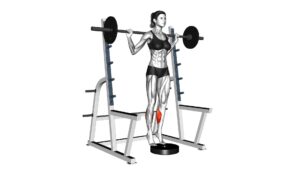Barbell Standing Leg Calf Raise – Video Exercise Guide & Tips

Looking to strengthen and tone your calf muscles? The Barbell Standing Leg Calf Raise is the perfect exercise for you!
Watch This Exercise Video
In this video exercise guide, we'll show you how to properly perform this exercise for maximum results. You'll learn step-by-step instructions, common mistakes to avoid, and tips for increasing intensity.
Whether you're a beginner or advanced fitness enthusiast, this exercise will help you achieve your goals.
Get ready to feel the burn and boost your calf strength with this effective workout.
Key Takeaways
- Strengthening and toning calf muscles effectively
- Targeting and developing calf muscles
- Increasing size and strength of calves
- Improving lower body strength and stability
Benefits of the Barbell Standing Leg Calf Raise
You can strengthen and tone your calf muscles effectively with the barbell standing leg calf raise. This exercise is a great way to target your calf muscles and promote calf muscle development. By performing the barbell standing leg calf raise, you can increase the size and strength of your calves.
One of the main benefits of the barbell standing leg calf raise is that it allows for exercise variations. You can adjust the weight on the barbell to challenge yourself and increase the intensity of the exercise. Additionally, you can perform the exercise using a single leg or both legs together, which further enhances the workout.
By incorporating the barbell standing leg calf raise into your exercise routine, you can specifically target your calf muscles and improve their strength and definition. This exercise not only helps you achieve a more toned and defined look, but it also improves your overall lower body strength and stability.
Proper Equipment Setup for the Exercise
To properly set up the equipment for the Barbell Standing Leg Calf Raise, you need to ensure correct weight placement and proper foot positioning.
Place the barbell on your shoulders with an appropriate weight that challenges your calf muscles.
Position your feet shoulder-width apart, toes pointing forward.
This setup will allow you to perform the exercise effectively and target your calf muscles efficiently.
Correct Weight Placement
To properly set up the equipment for the exercise, always securely fasten the weights to the barbell using the appropriate clips. Correct weight placement is crucial for maintaining balance and preventing injury during the Barbell Standing Leg Calf Raise.
Ensure that the weights are evenly distributed on both sides of the barbell to maintain stability and proper form. It's also important to consider ankle flexibility when determining the weight to use. If your ankles aren't very flexible, it's recommended to start with lighter weights and gradually increase as your flexibility improves.
Remember, the correct weight distribution and ankle flexibility are vital for maximizing the effectiveness of this exercise and preventing strain on your muscles.
Now let's move on to the next section, which covers proper foot positioning.
Proper Foot Positioning
Ensure proper foot positioning for the Barbell Standing Leg Calf Raise by aligning your feet with a shoulder-width distance apart. This positioning allows for optimal stability and balance during the exercise.
When setting up, make sure to place your feet parallel to each other and maintain a neutral foot arch. Keeping a neutral foot arch helps to distribute the weight evenly and prevent any excessive stress on the arch of your foot.
Additionally, maintaining proper ankle stability is crucial for executing the exercise correctly. Ensure that your ankles are in a stable position by keeping them aligned with your feet throughout the movement. This will help prevent any unnecessary strain or potential injuries.
Step-by-Step Guide to Performing the Exercise
Perform the barbell standing leg calf raise exercise by following these step-by-step instructions:
- Start by placing a barbell on your shoulders, behind your neck, and stand with your feet shoulder-width apart. Ensure that your feet are parallel to each other.
- Position your toes on a block or step, with your heels hanging off the edge. This will allow for a greater range of motion.
- Slowly raise your heels as high as possible, lifting your body up onto your toes. Hold this position for a brief pause to squeeze your calf muscles.
- Lower your heels back down to the starting position in a controlled manner. Repeat the movement for the desired number of repetitions.
By performing the barbell standing leg calf raise, you're targeting your calf muscles and improving their strength and definition. This exercise can be modified by using different variations such as dumbbells or kettlebells instead of a barbell.
Additionally, there are alternative exercises for calf development, such as seated calf raises, calf press on the leg press machine, or standing calf raises using a calf raise machine.
Incorporating these exercises into your routine will help you achieve well-rounded calf development.
Common Mistakes to Avoid
When performing the barbell standing leg calf raise, there are a few common mistakes to avoid.
First, make sure you have proper foot placement, as placing your feet too close together or too far apart can affect the effectiveness of the exercise.
Additionally, don't neglect the full range of motion – make sure you're going all the way up on your toes and all the way down to fully engage the calf muscles.
Lastly, maintaining proper balance is crucial to prevent any injuries or accidents during the exercise.
Improper Foot Placement
Proper alignment of the feet is crucial for optimal performance and injury prevention during the barbell standing leg calf raise exercise. Here are four common foot placement mistakes to avoid and tips for correcting foot positioning errors:
- Placing the feet too close together: This reduces stability and limits the range of motion. Instead, position your feet shoulder-width apart to maintain balance and engage the calf muscles effectively.
- Allowing the heels to lift off the ground: This puts excessive stress on the calves and can lead to injury. Keep your heels firmly planted throughout the exercise to ensure proper muscle activation and stability.
- Angling the feet inward or outward: This places strain on the ankles and can cause instability. Maintain a neutral foot position, with toes pointing forward, to distribute the workload evenly and prevent unnecessary stress.
- Failing to maintain proper arch support: This can lead to foot pain and instability. Ensure that your arches are supported by keeping your weight evenly distributed across the entire foot during the exercise.
Neglecting Full Range Motion
To avoid neglecting full range motion during the barbell standing leg calf raise, it's important to focus on maintaining a complete range of motion throughout the exercise. Neglecting full range motion can limit the effectiveness of the exercise and hinder your progress in improving calf strength.
When performing the barbell standing leg calf raise, make sure to fully extend your ankle and rise up onto your toes, allowing your calves to fully contract. Avoid rushing through the movement or stopping short of the full range of motion.
It's also worth noting that there are variations of calf raises that can target different areas of the calf muscles. Incorporating these variations into your calf training can help you achieve a well-rounded and balanced calf development.
Lack of Proper Balance
One common mistake to avoid during the barbell standing leg calf raise is failing to maintain proper balance. It's crucial to have good balance in order to perform this exercise effectively and prevent any injuries.
Here are four tips to help you improve stability and ankle strength while doing the barbell standing leg calf raise:
- Plant your feet firmly on the ground and distribute your weight evenly.
- Engage your core muscles to stabilize your body throughout the movement.
- Focus on keeping your ankles aligned and avoid rolling them inward or outward.
- Start with a lighter weight and gradually increase it as you build strength and confidence.
By following these tips, you'll be able to maintain proper balance and maximize the benefits of the barbell standing leg calf raise.
Now, let's move on to the next section where we'll discuss tips for increasing intensity and progressing.
Tips for Increasing Intensity and Progressing
To increase the intensity and progress in your barbell standing leg calf raise, you can incorporate these tips.
First, consider using increased resistance by adding more weight to the barbell. Gradually increase the weight as you become stronger to challenge your calf muscles even more. This will help to build muscle and improve strength.
Another way to increase intensity is by incorporating advanced variations of the exercise. One option is to perform the exercise on an elevated surface, such as a step or a sturdy platform. This will increase the range of motion and further engage your calf muscles. You can also try performing the exercise with one leg at a time to further challenge your balance and stability.
In addition to increasing intensity, it's important to focus on proper form and technique. Make sure to keep your core engaged and your back straight throughout the exercise. Avoid using momentum and instead, focus on controlled and slow movements. This will ensure that you're targeting the calf muscles effectively and reducing the risk of injury.
Remember to listen to your body and progress at your own pace. It's important to challenge yourself, but also to respect your body's limits. By incorporating these tips, you can take your barbell standing leg calf raise to the next level and continue to see progress in your calf strength and definition.
Safety Precautions and Modifications
To ensure your safety and make necessary modifications, it's important to consider several factors when performing the barbell standing leg calf raise exercise.
Here are some safety precautions and modifications to keep in mind:
- Start with a lighter weight: If you're new to this exercise or have any concerns about your calf strength, it's wise to begin with a lighter weight. This will allow you to focus on proper form and reduce the risk of injury.
- Use proper form: Maintain good posture throughout the exercise by keeping your back straight and shoulders relaxed. Avoid using momentum or excessive weight that can strain your lower back.
- Listen to your body: Pay attention to any discomfort or pain during the exercise. If you experience any sharp or prolonged pain, stop immediately and consult a healthcare professional.
- Alternative exercises: If you have any pre-existing injuries or limitations that prevent you from performing the barbell standing leg calf raise, there are alternative exercises you can try. Some examples include seated calf raises, standing calf raises with dumbbells, or using a calf raise machine.
Frequently Asked Questions
How Many Sets and Reps Should I Do for the Barbell Standing Leg Calf Raise?
To determine the number of sets and reps for the barbell standing leg calf raise, consider the benefits and variations of the exercise.
The barbell standing leg calf raise targets the calf muscles, helping to strengthen and tone them.
As for the sets and reps, it's recommended to start with 3 sets of 10-12 reps and gradually increase as you get stronger.
Remember to listen to your body and adjust the intensity as needed.
Can I Substitute the Barbell With Dumbbells or Other Equipment?
Yes, you can substitute the barbell with dumbbells or other equipment for the standing leg calf raise. Using dumbbells can provide several benefits for calf exercises. They allow for a greater range of motion and can help improve stability and balance.
Additionally, using dumbbells can help target different areas of the calf muscles. So, feel free to switch it up and use dumbbells or other equipment for this exercise.
What Muscles Does the Barbell Standing Leg Calf Raise Target?
The barbell standing leg calf raise primarily targets your calf muscles. It's a great exercise for building strength and size in your calves.
By using a barbell, you can add more resistance and challenge your muscles even more.
This exercise also helps improve your balance and stability.
If you're looking for variations, you can try using dumbbells or other equipment like a calf raise machine.
These variations can provide different angles and intensities to target your calf muscles.
Can I Do This Exercise if I Have a Previous Calf Injury?
If you're recovering from a calf injury, it's best to avoid the barbell standing leg calf raise. This exercise puts a lot of strain on the calf muscles and may hinder your recovery.
Instead, focus on alternative exercises that strengthen the calf without putting too much stress on it, such as seated calf raises or calf raises using body weight.
Additionally, incorporate stretching exercises to help with calf injury rehabilitation.
How Often Should I Incorporate the Barbell Standing Leg Calf Raise Into My Workout Routine?
To incorporate the barbell standing leg calf raise into your workout routine, you should aim to do it two to three times a week.
This exercise is a great addition to a full leg workout as it targets and strengthens your calf muscles.
Adding weight to your calf exercises, like with the barbell, can increase the intensity and provide additional benefits.
Conclusion
Incorporating the barbell standing leg calf raise into your workout routine can provide numerous benefits, such as strengthening and toning your calf muscles.
By following the proper equipment setup and step-by-step guide, you can ensure that you're performing the exercise correctly and effectively.
Avoiding common mistakes and implementing tips for increasing intensity will help you progress and achieve your fitness goals.
Remember to prioritize safety and make any necessary modifications to suit your individual needs.

Author
Years ago, the spark of my life’s passion ignited in my mind the moment I stepped into the local gym for the first time. The inaugural bead of perspiration, the initial endeavor, the very first surge of endorphins, and a sense of pride that washed over me post-workout marked the beginning of my deep-seated interest in strength sports, fitness, and sports nutrition. This very curiosity blossomed rapidly into a profound fascination, propelling me to earn a Master’s degree in Physical Education from the Academy of Physical Education in Krakow, followed by a Sports Manager diploma from the Jagiellonian University. My journey of growth led me to gain more specialized qualifications, such as being a certified personal trainer with a focus on sports dietetics, a lifeguard, and an instructor for wellness and corrective gymnastics. Theoretical knowledge paired seamlessly with practical experience, reinforcing my belief that the transformation of individuals under my guidance was also a reflection of my personal growth. This belief holds true even today. Each day, I strive to push the boundaries and explore new realms. These realms gently elevate me to greater heights. The unique combination of passion for my field and the continuous quest for growth fuels my drive to break new ground.



